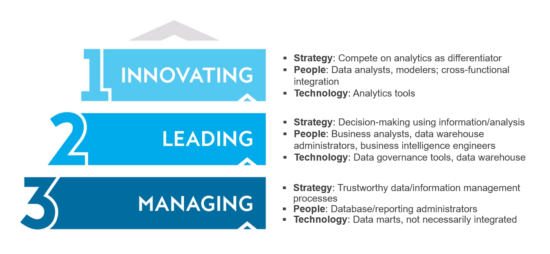

In a prior role, I worked on the analytics team of a Fortune 125 financial services firm, arguably one of the best in the country in applying analytics across all business strategy decisions. At this firm, we spent an inordinate amount of time obsessing over the design of the analysis that would prove or disprove a business strategy question. This may sound like a bunch of statisticians and math nerds trying to run the business, but the opposite was true. This firm had people with engineering, arts, business, statistics and banking backgrounds who made it all happen and made it a success.
Most banks and credit unions that have recently dabbled in analytics at their institutions don’t have a success story to tell. There are the oft-cited broad reasons why analytics initiatives fail such as lack of executive sponsorship, corporate culture not steeped in analytics, and siloed initiatives that get executed poorly. But three deeper reasons are causing the failures:
Technology without execution capabilities
In a recent study, Cornerstone Advisors found that among 100 analytics vendors, 53% have a business intelligence/visualization solution, 39% provide various methods to conduct deep analysis, and less than 5% provide services to execute on the intelligence derived from the analysis. Having the best technology for data analytics does not automatically translate to execution success.
Marketing campaigns without clear purpose
One area within a financial institution that is execution-focused is the marketing team. But when a business strategy that needs to be proved or disproved through marketing campaigns lacks clarity, it leads to inconsistent results and an inability to measure and analyze the campaigns’ success or failure.
Vendors looking for a needle in a haystack
Analytics vendors tout their wares to be able to find deep insights by analyzing financial institutions’ internal and external data sources. These vendors are truly looking for a needle in a haystack to find analytics-based insights. The vendors do not know the surgically precise business questions that need to be hypothesized to analyze the structured and unstructured data to derive insights.
Here is a key analogy I like to share with my clients about analytics endeavors:
“Saying I want to be successful with analytics is analogous to saying I want to be successful with my business strategy.”
Like business strategy, analytics is broad and deep. A financial institution can’t simply rely on outsourcing all its business strategy work to drive success. In the same way, it can’t outsource its way into analytical success. In this frame of reference, there are three steps a financial institution can take to move toward analytics success:
Data, tools and process are the three pillars for enabling analytics. But only process truly drives analytics success. Financial institutions achieve analytics success by developing a clear process playbook that defines how they will (a) Create the business strategy hypothesis; (b) Intelligently analyze data to prove or disprove this hypothesis; and (c) Most importantly, go full circle by properly executing analytics-related campaigns.
Any analysis must be vetted for statistical significance before informed business strategy decisions can be made. If the bank’s marketing team came to the management team and proclaimed that the latest credit card campaign was a success, how many of the managers could challenge the marketing team on the statistical significance of the data presented?
Without a clear understanding of how campaign results are measured and analyzed, any analysis presented in a financial institution can lead to a “he said, she said” discussion, one that could derail an otherwise successful analytics project or promote an incorrect analysis of an ongoing business strategy. The importance of data-related knowledge needed to pursue analytics initiatives can’t be overemphasized.
Managing, Leading, and Innovating are the three level of analytics maturity. Financial institutions that reach the Leading stage of maturity have a clear process playbook for conducting repeatable analytics projects cross-functionally across various areas of the financial institution. It takes focused effort across strategy, people, and technology to climb this analytics maturity ladder as illustrated below:

In summary, anyone – whether from within or outside your organization – who tries to sell you the concept of achieving big data analytics success without presenting a clear plan on the process of analytics, relevance of statistical significance, and a roadmap to climb the analytics maturity ladder is taking you down that wrong road filled with glittering fake promises. You have been warned!